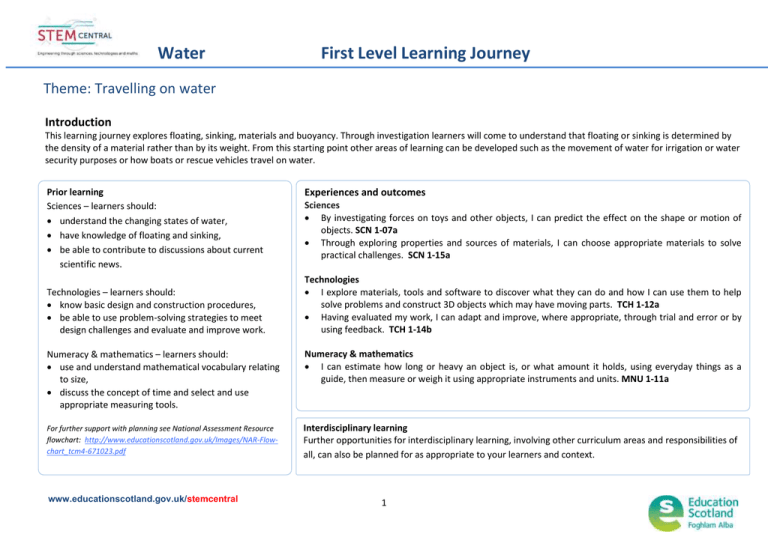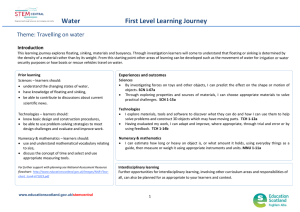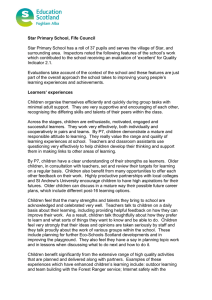Water ... Introduction
advertisement

Water First Level Learning Journey Theme: Travelling on water Introduction This learning journey explores floating, sinking, materials and buoyancy. Through investigation learners will come to understand that floating or sinking is determined by v the density of a material rather than by its weight. From this starting point other areas of learning can be developed such as the movement of water for irrigation or water security purposes or how boats or rescue vehicles travel on water. Prior learning Sciences – learners should: understand the changing states of water, have knowledge of floating and sinking, be able to contribute to discussions about current scientific news. Technologies – learners should: know basic design and construction procedures, be able to use problem-solving strategies to meet design challenges and evaluate and improve work. Experiences and outcomes Sciences By investigating forces on toys and other objects, I can predict the effect on the shape or motion of objects. SCN 1-07a Through exploring properties and sources of materials, I can choose appropriate materials to solve practical challenges. SCN 1-15a Technologies I explore materials, tools and software to discover what they can do and how I can use them to help solve problems and construct 3D objects which may have moving parts. TCH 1-12a Having evaluated my work, I can adapt and improve, where appropriate, through trial and error or by using feedback. TCH 1-14b Numeracy & mathematics – learners should: use and understand mathematical vocabulary relating to size, discuss the concept of time and select and use appropriate measuring tools. Numeracy & mathematics I can estimate how long or heavy an object is, or what amount it holds, using everyday things as a guide, then measure or weigh it using appropriate instruments and units. MNU 1-11a For further support with planning see National Assessment Resource flowchart: http://www.educationscotland.gov.uk/Images/NAR-Flowchart_tcm4-671023.pdf Interdisciplinary learning Further opportunities for interdisciplinary learning, involving other curriculum areas and responsibilities of all, can also be planned for as appropriate to your learners and context. www.educationscotland.gov.uk/stemcentral 1 Water Stimulus The topic can be introduced by reading age-related stories that explore the ideas of floating /sinking and boat building e.g. Toy Boat by Randall de Seve; Busytown Boat Race by Richard Scarry; The Boy Who Built the Boat by Ross Mueller; Who Sank the Boat? by Pamela Allen; Curious George: The Boat Show by Kate O’Sullivan. C Skills Through research activities and practical investigations learners will develop skills in: inquiry and investigation, observation and making predictions, analytical thinking – relating to success/ failure in group or individual tasks, interpretation and evaluation of information – when making sense of results, draw valid conclusion, presenting and justifying opinions, planning and organising through the challenges. For more info on skills visit: Building the Curriculum 4 and Sciences Principles and Practice at http://www.educationscotland.gov.uk/sciences www.educationscotland.gov.uk/stemcentral First Level Learning Journey Suggested key learning Learning activities Learning intentions and success criteria should be established through dialogue with learners. watch videos of a variety of vessels (http://bit.ly/M2oF4A) designed for a particular purpose e.g. lifeboat or container ship. Discuss and record observations, identify objects made of different materials and of various masses. Estimate dimensions and mass using everyday objects as a guide and then measure. Record if objects float or sink. What do these materials have in common? See (http://bit.ly/1isUQaN), Learners can: explain how the shape of a vessel/ boat influences its ability to float, explain buoyancy using the term up thrust force – Archemides Principle, explain concept of density in their own words, select appropriate material and use the correct tools to construct a boat that floats, adjust a design or model explaining modifications, recognise and discuss the different ways water is used within technologies to help us e.g. water wheel for power, estimate and measure volume using appropriate equipment and vocabulary, interpret and collate and present data in a table or chart, research, analyse, interpret and present information to explain, support or develop an issue reported in the media. engage in the design and make process by constructing a boat that floats, predict, explore and explain what will happen during investigations and design challenges. Evaluate and modify as required. Record through notes and drawings, research a current/recent local or global event i.e. canal or dam construction or how a lock works. Identify cause and effect. Present research through medium of choice justifying conclusions through reference, use 250g/ 500g/ 1 kg masses and estimate how much water would be required in a container for it to float (extension possible), create an appropriate chart that organises and displays the results of investigations, topical science – use current news stories about water, buoyancy and transport on water. Find out about Archimedes’ Principle: http://bit.ly/1c9FBjm 2 Water Reflecting on learning Dialogue with learners will establish how the design principles were addressed. Relate the prompts below to your own context. Breadth – What other curricular areas were covered during this topic? Can you relate learning to areas of real life and /or school learning? First Level Learning Journey Evidence of learning Possible methods of assessment are listed below. Select as appropriate or devise your own. Say: Verbally explain predictions, estimations and actual results of an investigation as seen on table or chart. Make links from their learning experiences to real-life situations. http://www.jou rneytoexcellence.org.uk /videos /netherlees cience.as p Personalisation and choice – Were you given the opportunity to choose your own methods of investigation or recording? Depth – Were you given the opportunity to show what you have learned and explain your learning to others? Have you led learning in any way? Coherence – Can you discuss some of the knowledge, understanding and skills you have developed? How have you used these? Can you relate them to real life or other areas of learning? Progression – Have you used the skills and knowledge and understanding you already had of the subject and have you built on these? Relevance – Can you identify an everyday context where you would use your knowledge, understanding and skills? Challenge & enjoyment – Did you enjoy the learning? Why/why not? Was it challenging enough? Can you suggest how to take learning further? Write: Write a simple, coherent explanation for buoyancy e.g. of boats. Make: Complete a design challenge related to floating and sinking – make a boat selecting appropriate materials and containers. Through a ‘predict, observe and explain’ sequence explain and discuss the various factors involved in their investigations and challenges and give possible explanations for their findings. Is model fit for purpose? Do: Undertake a practical activity and explain, through demonstration and questioning, how the shape of an object can influence the way it moves in water. For more information see Assessing progress and achievement resource at http://www.educationscotland.gov.uk/sciences Taking learning further Find ways to deepen and extend learning through dialogue with learners. Suggestions to challenge learners: Explain the difference in buoyancy between salt water and fresh water. Compare and record the height above the water surface of an object in both salt and fresh water. To further explore density the learners could complete a ‘Colourful Column’ team challenge where they create a colour column by adding a variety of liquid ingredients (syrup, oil, washing-up liquid, milk etc.) to tall measuring cylinders containing coloured water. They could extend this further by dropping small objects into the columns. See the Sciences Concept Development Paper for more guidance: http://www.educationscotland.gov.uk/sciences www.educationscotland.gov.uk/stemcentral 3





